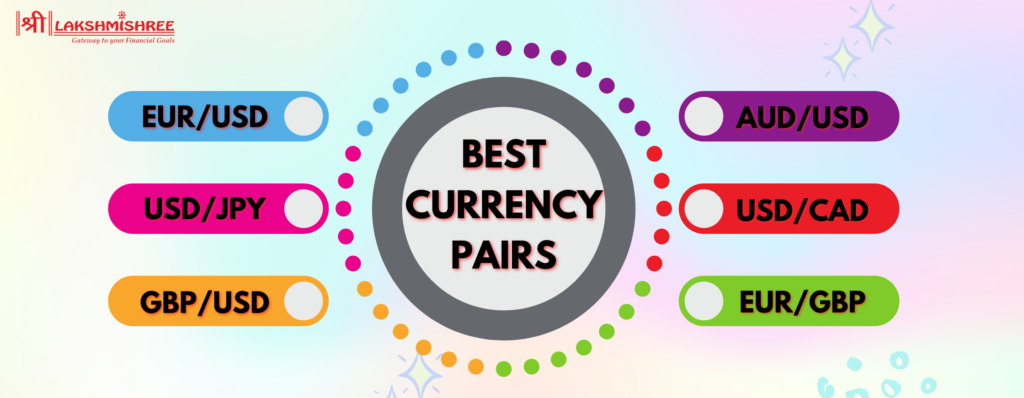
The foreign exchange market, or forex, is the largest financial market globally. It's where currencies are traded against each other. When you trade forex, you're speculating on the rise or fall of a particular currency's value relative to another. This guide explores some of the best currency pairs to trade and factors to consider when choosing trading strategies for each pair.
In India, currency trading is restricted to seven pairs: USD/INR, EUR/INR, JPY/INR, GBP/INR, EUR/USD, GBP/USD, and USD/JPY. These transactions are facilitated by three stock exchanges, namely NSE, BSE, and Metropolitan Stock Exchange of India, all regulated jointly by SEBI and RBI.
Currencies are always traded in pairs. This means that when you buy one currency, you automatically sell another. In each pair, there's a base currency and a quote currency. The base currency is listed first, and the quote currency is second.
For example, in EUR/USD (Euro/US Dollar), EUR is the base currency, and USD is the quote currency. A quote of 1.2000 for EUR/USD means one euro is worth 1.20 US dollars.
There are three main categories of forex currency pairs:

In India, the forex market offers opportunities to trade seven currency pairs, each with unique characteristics and trading strategies. Let's explore 6 best currency pairs to trade in India out of those:
| 6 Best Currency Pairs to Trade in India |
|---|
| 1. JPY/INR (Japanese Yen/Indian Rupee) |
| 2. USD/JPY (US Dollar/Japanese Yen) |
| 3. USD/INR (US Dollar/Indian Rupee) |
| 4. EUR/USD (Euro/US Dollar) |
| 5. EUR/INR (Euro/Indian Rupee) |
| 6. GBP/INR (British Pound/Indian Rupee) |
The Japanese yen (JPY) and the Indian rupee (INR) pair can be volatile, making it suitable for traders who prefer short-term trading strategies. Given the yen's safe-haven status, traders often monitor geopolitical events and economic indicators to anticipate market movements.
The USD/JPY pair is known for its liquidity and responsiveness to global economic trends. Traders often utilize fundamental analysis, focusing on interest rate differentials between the US Federal Reserve and the Bank of Japan.
As one of India's most actively traded currency pairs, USD/INR offers ample liquidity and trading opportunities. These are the best currency pairs to trade in India. Swing and position trading are popular strategies, with traders monitoring macroeconomic factors such as interest rates, inflation, and geopolitical events.
The EUR/USD pair is favoured by traders globally for its liquidity and relatively low spreads. Range trading and trend following are common strategies, with traders using indicators like the Relative Strength Index (RSI) and Bollinger Bands to identify overbought or oversold conditions.
Trading the EUR/INR pair requires attention to both European and Indian economic developments. Swing and breakout trading are effective strategies, with traders monitoring key support and resistance levels. Fundamental analysis, including interest rate differentials and economic data releases, can provide valuable insights into market direction.
The GBP/INR pair is influenced by economic trends in the United Kingdom and India as well as geopolitical factors. Trend and momentum trading are popular strategies, with traders using indicators like moving averages and MACD to identify trends. Traders should also pay attention to central bank announcements and Brexit-related developments.
Several factors come into play when choosing the best currency pairs to trade:
Currency pair trading strategies involve various approaches and techniques traders use to profit from fluctuations in exchange rates between two currencies. These strategies analyze market conditions, economic indicators, and other factors to make informed decisions about buying or selling currency pairs. Some common currency pair trading strategies include:
These are just a few examples of currency pair trading strategies, and traders often combine multiple strategies or tailor them to suit their trading styles, risk tolerance, and market conditions.
According to RBI, Trading on recognized exchanges such as the BSE, NSE, or MSE is allowed, but engaging in transactions on unauthorized platforms is strictly prohibited. Violations, including trading in unapproved currency pairs or utilizing illegal platforms, may lead to fines of up to Rs 10,000 per day and possibly imprisonment for up to five years.
The forex market offers various currency pairs to trade, each with its characteristics and trading opportunities. By understanding the factors that influence currency movements and employing suitable trading strategies, you can increase your chances of success in the forex market. The provided list of the best currency pairs to trade can enhance your research.
Forex trading carries inherent risks, and conducting thorough research and analysis is crucial before making any trades. Consider starting with a demo account to practice your trading strategies before risking real capital.
Currency pairs traded refer to the combinations of two currencies in the foreign exchange market. These pairs are traded against each other, and their relative value determines the exchange rate.
In India, traders can access a limited number of 7 currency pairs. These include:
1. JPY/INR (Japanese Yen/Indian Rupee)
2. USD/JPY (US Dollar/Japanese Yen)
3. USD/INR (US Dollar/Indian Rupee)
4. EUR/USD (Euro/US Dollar)
5. EUR/INR (Euro/Indian Rupee)
6. GBP/INR (British Pound/Indian Rupee)
7. GBP/USD (British Pound/US Dollar)
An example of a currency pair is EUR/USD, where EUR is the base currency and USD is the quote currency.
Yes, currency pair trading is legal in India, but it is subject to certain regulations and restrictions enforced by regulatory bodies like SEBI and RBI.
